Chrissy, Opal and I joined our good buddies, Ron and Faye Burke, at one of
their favorite Douglas Lake locations to hunt for Douglas Lake diamonds (actually quartz crystals).
The term "Douglas Diamonds" was coined by area rockhounds many years ago because they resemble
Herkimer Diamonds (distinctive quartz crystals found in the Herkimer area of New York). A rockhound
who lives in that area told me told me that local kids trade the diamonds like marbles.
Just as in the Herkimer area of New York, I believe that there are pockets, albeit
much smaller,
in the limestone that contain quartz crystals. The crystals formed from silica-rich hydrothermal
solutions that flowed through fractures in the limestone. As later weathering dissolved the
limestone, the chemically resistant quartz crystals were liberated and were incorporated within
the sandy clay residuum. The fact that most of the quartz crystals are perfectly sharp with
virtually no damage or etching indicates that they have not been transported by streams or other
actions but remain very near where they formed. Breaking limestone boulders in areas where quartz
crystals exist in the overlying residuum would likely reveal quartz-containing pockets. This
arduous task would not be worth the trouble as any quartz crystals would almost certainly be
shattered by the concussion - not to mention that it is illegal to bust rocks in a TVA-managed
area, including Douglas Lake.
Each winter, the Tennessee Valley Authority significantly lowers the man-made lake
level for flood control thus resulting in large expanses of dry lake bottom where quartz crystals
may be found as float in the mud and gravel. There are many areas on the lake to hunt for quartz,
but only a few where the highest quality crystals may be found. The crystals are found by walking
back and forth over the former-lake bottom while keeping a keen eye on the ground.
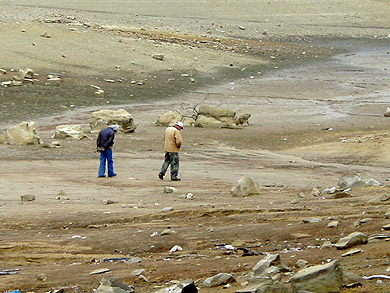
Ron and Faye Burke hunting for elusive Douglas Lake diamonds
We rockhounded for several hours before a strong wind picked up and the temperature
plummeted. It took only 1/2-hour for the temperature to drop from 45-degrees to around
30-degrees with a wind gusting to around 30 mph. So much for a weather forecast of 45-degrees
and sunny all day. Before we were chased out by the cold, we all managed to find at least one crystal
that would more than make up for us freezing our butts off. The following pictures show Chrissy's
and my best two crystals.
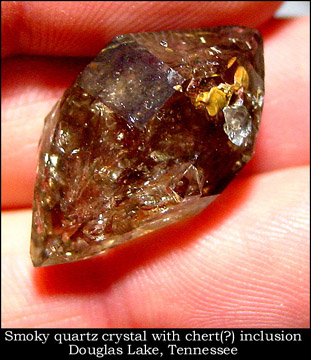 |
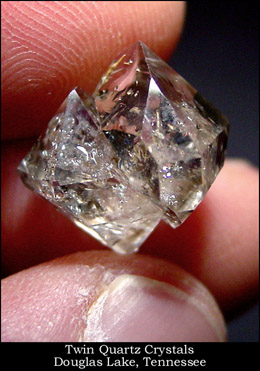 |
Click on each specimen picture to enlarge
My smoky diamond contains two inclusions of what appears to be chert
on each side of the crystal. The following picture shows a close-up of one of the inclusions and
also the smoky crystal back-lit.
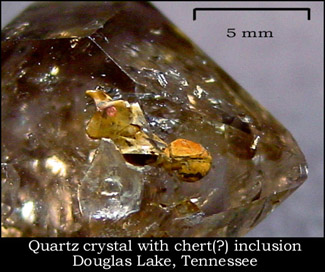
|
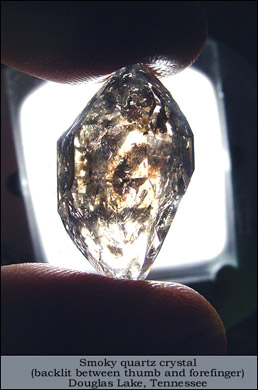
|
Click on each specimen picture to enlarge
Ron and Faye's lake bottom area also had a few rocks that contained beautiful
banded calcite veins. I was able to recover the following excellent blocky calcite specimen.
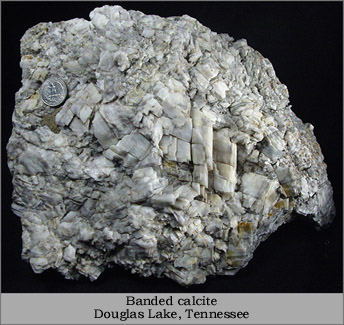
|
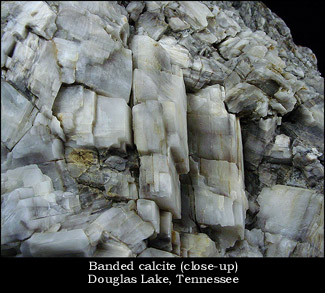
|
Click on each specimen picture to enlarge
We drove home through snow flurries but we didn't care because we had some
nifty little Douglas Lake diamonds safely stowed in our pockets and another fond memory of a day
spent with our good friends.
Chrissy and I returned to join Ron and Faye Burke to hunt the lake again on
February 6, 2005. It was a warm sunny day this time around. We found a
few decent specimens during the day, but, late in the afternoon at the last place we stopped,
Chrissy found a magnificent complex crystal cluster. I'll let the following three pictures of
the specimen speak for themselves.
Click on each picture to enlarge
I took the following picture of another Douglas Diamond. This bad boy is a perfectly formed
twin. Pretty nice, right?!
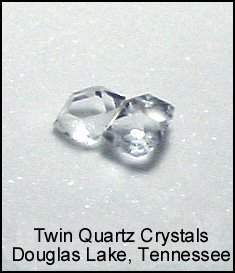
But, the following picture demonstrates the most amazing aspect of the crystal
twin - it's incredibly small size! The picture also shows the importance of always including some
sort of scale in a rock or mineral picture.
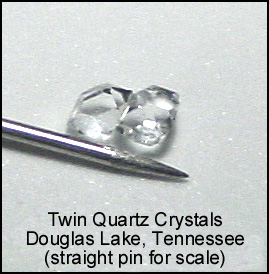
We have found complete quartz crystals at Lake Douglas that are no bigger than
a tiny grain of sand. I wonder how small those little dudes get??? You micro guys would get a
kick out of this place!
Proceed to the next page for more Diamond pictures . . . . . . .
Click Here for Next Page